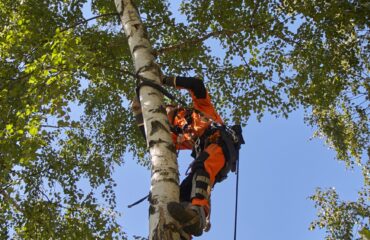
Archer Tree Services Curated Tips for Each Season
Proper tree care is crucial for both the well-being of your trees and the safety of your home and family. Neglected trees can become hazards, posing risks to structures, power lines, and people. Understanding your trees’ needs is the first step toward ensuring their longevity and our safety.
Archer Tree Services has created a comprehensive guide to healthy tree maintenance, combining expert advice with practical, easy-to-follow steps that every homeowner can use to care for their trees. Drawing upon decades of experience, our experts have distilled their knowledge into this accessible resource. Whether you’re a seasoned gardener or a novice tree enthusiast, you’ll find valuable insights to keep your trees thriving.
Our guide covers tree care for every season, ensuring your trees remain strong and vibrant year-round. We delve into the intricacies of soil health, explaining how to choose the right type of soil and amendments to foster robust root systems. Watering techniques emphasize the importance of deep watering to prevent problematic surface roots. Pruning tips help you understand the optimal times and methods to trim your trees for growth and safety.
By following the recommendations in this guide, you’ll not only enhance the beauty and health of your trees but also contribute to a safer environment for your family and loved ones. Join us on this journey toward creating a healthier, safer, and more beautiful yard.
The Ultimate Healthy Trees Maintenance Checklist
Year-round healthy tree maintenance strategies can include inspection, proper pruning techniques, efficient watering methods, and preventive measures against diseases and pests. Adopting such practices allows homeowners to create healthy growth, minimize potential hazards, and improve the aesthetics of the landscape. After reading these expert-recommended tactics, you will feel empowered with the necessary tools to properly care for your trees.
Planting with Purpose
The phrase “Right tree, right place” should be every homeowner’s guide. Before planting, consider the tree’s mature size, root behavior, and light requirements to ensure it won’t interfere with buildings, power lines, or other structures. Dig a planting hole twice as wide as the root ball but no deeper to prevent settling. Stabilize the tree with stakes only if necessary, and be sure to water thoroughly after planting to settle the soil.
Nourishing Roots: Proper Watering and Soil Maintenance
Trees, like us, flourish with proper nutrition and hydration. Young healthy tree maintenance especially requires consistent watering to establish deep roots. A general rule for all trees is to water deeply but less frequently, fostering robust root growth. This method ensures water reaches deeper soil layers, encouraging roots to extend further and increasing their resilience over time.
Equally crucial is soil quality. Aerating compacted soil improves water absorption and oxygen flow to the roots, vital for the tree’s overall health. Compacted soil can restrict root expansion and limit access to essential nutrients and moisture. By testing your soil’s pH and nutrient levels, you can identify what your trees need or might be receiving in excess. Effective soil management, including adding organic matter or specific nutrients, can significantly enhance tree growth and vitality. Regular mulching also helps maintain soil moisture and temperature, further supporting a healthy environment for root development.
The Protective Blanket of Mulch
Mulching is a simple yet highly effective gardening technique that offers numerous benefits. By applying a layer of mulch around the base of your trees, you can regulate soil temperature, retain moisture, and significantly reduce weed competition, which otherwise competes with your trees for nutrients and water. Furthermore, organic mulches like shredded bark, compost, or leaves not only fulfill these functions but also enhance soil fertility as they decompose, enriching it with essential nutrients.
However, it’s crucial to avoid excessive mulching, commonly known as “volcano mulching,” which can suffocate tree roots and hinder growth. For healthy tree maintenance, spread the mulch evenly and keep it a few inches away from the trunk. This gap helps prevent rot and other issues caused by excessive moisture around the tree base. Proper mulching techniques foster healthier trees and more vibrant gardens, making it an indispensable practice for any gardener.
The Right Time and Way to Fertilize
Fertilization can significantly benefit trees, but more isn’t always better. The need for fertilization largely depends on a tree’s age, species, and the existing nutrient levels in the soil. For example, younger trees might require different nutrients compared to mature ones, and various species have unique nutritional needs. Additionally, soil conditions change over time, affecting nutrient availability.
Using slow-release fertilizers during the growing season can enhance tree health without causing stress. This type of fertilizer gradually releases nutrients, ensuring a steady supply over time rather than overwhelming the tree with a sudden influx. Conducting soil tests is crucial for guiding your fertilization strategy, helping you effectively complement the soil’s natural nutrient profile. By understanding the specific needs of your trees and soil, you can optimize growth, improve resilience against pests and diseases, and promote overall yard health.
The Crucial Role of Regular Pruning
Pruning goes beyond enhancing a tree’s visual appeal; it’s a crucial healthy tree maintenance task that eliminates dead or dying branches, reduces disease risk, and encourages vigorous growth. Proper seasonal pruning allows sunlight and air to penetrate the tree’s canopy, bolstering its strength and vitality. Timing and technique are critical—improper pruning can cause stress and damage. For best results, consider consulting professionals like those at Archer Tree Services.
Guarding Against Invaders: Pest and Disease Management
Vigilant monitoring of pest populations and disease indicators can prevent minor issues from escalating into major problems. Regularly inspect your trees, focusing on changes in leaf color or texture, unusual growths, or premature leaf drop. Early detection is crucial, enabling timely intervention before issues worsen. Implement Integrated Pest Management (IPM) strategies, which may include biological control methods like introducing beneficial insects, mechanical interventions such as pruning affected areas, and, if necessary, the careful use of pesticides to minimize environmental impact. By combining these methods, you can effectively safeguard your trees from various threats, ensuring their health and longevity.
Adapting to Weather and Seasonal Changes
Each season brings its own set of challenges and tasks for healthy tree maintenance. Spring is the time for planting and early pest detection, summer demands rigorous watering schedules, fall is ideal for mulching and final pruning, and winter often necessitates protective measures against cold and physical damage. Awareness of weather extremes and proactive measures can greatly mitigate their impact on tree health.
Seasonal Tree Care: Nurturing Resilient and Thriving Trees
Caring for trees is a dynamic process that requires season-specific strategies to ensure their health and longevity. Each season introduces unique challenges and opportunities for healthy tree maintenance, from planting and pest control in the spring to rigorous watering in the summer, mulching in the fall, and protection against the cold in the winter. Recognizing and adapting to these seasonal variations is fundamental for nurturing resilient and thriving trees. This section will guide you through tailored tree care practices for each season, helping you provide consistent and effective support for your trees year-round.
Spring: A Season of Renewal
Spring is a pivotal time for trees as they awaken from winter dormancy and enter a phase of new growth. This season is excellent for planting new trees, taking advantage of the soil’s moisture to support root establishment and build strong foundations. Utilize this period to prune any dead or damaged branches, promoting healthy development and encouraging fresh growth.
Additionally, an important part of healthy tree maintenance is inspecting your trees for pest activity, as warmer weather increases pest presence, potentially causing significant damage if not promptly addressed. Proper fertilization during spring provides essential nutrients for robust growth, setting the stage for trees to thrive throughout the year. Remember to mulch around the tree bases to retain moisture and regulate soil temperature, further bolstering their health and vitality.
Summer: Sustaining Growth and Health
During summer, trees enter their peak growth phase, making consistent watering crucial, especially during droughts when water scarcity can stress them. Opt for deep, infrequent watering to foster robust root systems that reach deeper soil moisture. Regularly inspect your trees for pests and diseases, addressing any issues promptly with pest management strategies to minimize damage and promote healthy growth.
Mulching also helps retain soil moisture and reduce weed competition; however, avoid over-mulching, as it can lead to root rot and other complications. Mid-season pruning is also beneficial, managing growth, removing dead or diseased branches, and enhancing air circulation within the canopy to lower the risk of fungal infections. By following these healthy tree maintenance practices, you can ensure your trees remain vibrant throughout the summer.
Autumn: Preparing for Dormancy
In autumn, trees naturally slow down in anticipation of the colder months, making it the perfect time for essential care. Mulching during this season insulates the soil and roots against temperature fluctuations, retains moisture, and mitigates frost effects. Perform a final round of pruning to remove dead or diseased branches and shape the tree for healthy growth.
Fertilizing in the fall allows vital nutrients to be stored in the roots, providing a strong start for the next growing season. Additionally, address any pest or disease issues before winter arrives to ensure the tree remains healthy and resilient through harsh weather. Proper autumn preparation sets the stage for vibrant growth and flourishing health in the spring.
Winter: Protecting Against the Elements
To protect trees from winter’s harsh conditions, take these measures:
- Apply a fresh layer of mulch to insulate and retain soil moisture.
- Inspect trees for structural weaknesses, removing any dead or weakened branches that might break under snow or ice.
- Wrap the trunks of young or thin-barked trees to prevent frost cracks and temperature damage.
- Brace or shield any trees vulnerable to snow buildup or strong winds.
- These steps will help ensure your trees stay healthy throughout the winter season.
By understanding and addressing the unique needs of trees in each season, homeowners can foster healthy, resilient trees year-round. Adapting your healthy tree maintenance routine to seasonal changes ensures that your trees thrive, bringing beauty and benefits to your property for generations to come.
Proactive Tree Care Practices for Healthy Trees in Atlanta
Maintaining the health of your trees in Atlanta requires a proactive approach to tree care throughout the year. By adopting season-specific practices such as pruning, mulching, and fertilizing, homeowners can help their trees endure regional climatic challenges and thrive over the long term. Each season brings unique demands, and adjusting your care routine accordingly ensures your trees receive the right attention at the right time.
Regular monitoring for pests and diseases is also crucial in tree care. Timely intervention can prevent minor issues from escalating into major problems, safeguarding your trees from potential threats. Proper irrigation, particularly during the hot summer months, supports deep root growth and enhances the overall resilience of your trees. Winter measures to protect against cold and frost damage are essential for the survival and flourishing of young and sensitive trees.
Year-round tree care involves following best practices, and professional assistance can significantly enhance the health and safety of your trees. Archer Tree Services offers specialized pruning and removal services to maintain tree health. Our pruning services eliminate dead or damaged branches, promoting healthy growth and preventing hazards. Regular pruning also reduces the risks of disease and pests. When tree removal is necessary due to disease, storm damage, or safety concerns, Archer Tree Services ensures efficient and safe removal, using proper techniques to avoid damage. Leveraging their expertise guarantees well-maintained trees and safe, attractive properties.
By adhering to these healthy tree maintenance guidelines, homeowners can enjoy the numerous benefits that thriving trees bring to their properties, including aesthetic appeal, shade, and improved environmental quality. Investing time and effort into understanding and meeting your trees’ seasonal needs lays the groundwork for vibrant and robust growth. Ultimately, well-maintained trees can enhance your home’s value and contribute to a greener, more sustainable community for years to come.



